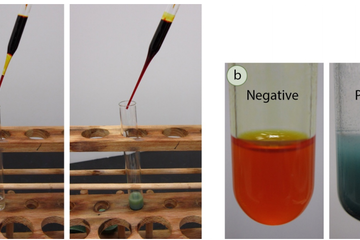We found 31 results that contain "tag 1"
Posted on: #iteachmsu

Health concerns - test articles
Common Health Concerns
Understanding common health concerns and what can be done to prevent or treat them can go a long way towards reducing the stress you feel when it comes to your health and the health of those in your care.
Whether you have seen a health story on the news, your child has come home from school with a note about immunizations, or your teenage daughter wants to go to another country on an exchange program, you are looking for information to guide you through the steps toward making informed health decisions. Having easy to understand health information at your fingertips will help you to focus on the key facts and save time.
In this section, there are information topics about some of the most common health concerns, so it is easy for you to find what you are looking for as quickly as possible.
Understanding common health concerns and what can be done to prevent or treat them can go a long way towards reducing the stress you feel when it comes to your health and the health of those in your care.
Whether you have seen a health story on the news, your child has come home from school with a note about immunizations, or your teenage daughter wants to go to another country on an exchange program, you are looking for information to guide you through the steps toward making informed health decisions. Having easy to understand health information at your fingertips will help you to focus on the key facts and save time.
In this section, there are information topics about some of the most common health concerns, so it is easy for you to find what you are looking for as quickly as possible.
Authored by:
Chathuri

Posted on: #iteachmsu


Health concerns - test articles
Common Health Concerns
Understanding common health concerns a...
Understanding common health concerns a...
Authored by:
Friday, Nov 8, 2019
Posted on: #iteachmsu

PEDAGOGICAL DESIGN
How does Finland’s top-ranking education system work?
How does Finland’s top-ranking education system work?
Finland has been a top contender on every Program for International Student Assessment survey.
The country built a comprehensive education structure designed to offer citizens free education with no dead ends.
The inspiration for Finland's approach was American education research and philosophers such as John Dewey.
Finland's education system enjoys a lot of buzz lately. It is considered one of the best education systems in the world. It routinely outperforms the United States in reading, science, and mathematics. And it has been a top performer since the first Program for International Student Assessment (PISA) triennial international survey back in 2000.
But ask someone what's so great about Finland's schools, and you'll typically be supplied with a factoid or three. They have shorter school days. They don't do standardized tests. They all must be smart because the Finnish language is a nightmare.
While these facts are true — except for that last one — they miss Finland's well-raked forests for its trees. Finland's education system works because its entire structure has been around several core principles. First and foremost, equal access to education is a constitutional right. Another important principle is that one should be allowed to choose their educative path, which should never lead to a dead end.
Here's how Finland's education system works to meet those principles.
Finland has been a top contender on every Program for International Student Assessment survey.
The country built a comprehensive education structure designed to offer citizens free education with no dead ends.
The inspiration for Finland's approach was American education research and philosophers such as John Dewey.
Finland's education system enjoys a lot of buzz lately. It is considered one of the best education systems in the world. It routinely outperforms the United States in reading, science, and mathematics. And it has been a top performer since the first Program for International Student Assessment (PISA) triennial international survey back in 2000.
But ask someone what's so great about Finland's schools, and you'll typically be supplied with a factoid or three. They have shorter school days. They don't do standardized tests. They all must be smart because the Finnish language is a nightmare.
While these facts are true — except for that last one — they miss Finland's well-raked forests for its trees. Finland's education system works because its entire structure has been around several core principles. First and foremost, equal access to education is a constitutional right. Another important principle is that one should be allowed to choose their educative path, which should never lead to a dead end.
Here's how Finland's education system works to meet those principles.
Authored by:
Chathuri

Posted on: #iteachmsu


How does Finland’s top-ranking education system work?
How does Finland’s top-ranking education system work?
Finla...
Finla...
Authored by:
PEDAGOGICAL DESIGN
Wednesday, Oct 9, 2019
Posted on: #iteachmsu

ASSESSING LEARNING
Chemical testing overview
Overview
Before spectroscopic analysis (IR, NMR) became commonplace in the organic chemistry lab, chemical tests were heavily relied upon to support compound identification. A chemical test is typically a fast reaction performed in a test tube that gives a dramatic visual clue (a color change, precipitate, or gas formation) as evidence for a chemical reaction. For example, addition of an orange chromic acid reagent to some compounds causes the chromium reagent to change to a blue-green color (Figure 6.37a). This is considered a "positive" test result, and in this case indicates the presence of a functional group that can be oxidized (alcohol or aldehyde). A negative test result is retention of the original color of the reagent, in this case the orange color
Before spectroscopic analysis (IR, NMR) became commonplace in the organic chemistry lab, chemical tests were heavily relied upon to support compound identification. A chemical test is typically a fast reaction performed in a test tube that gives a dramatic visual clue (a color change, precipitate, or gas formation) as evidence for a chemical reaction. For example, addition of an orange chromic acid reagent to some compounds causes the chromium reagent to change to a blue-green color (Figure 6.37a). This is considered a "positive" test result, and in this case indicates the presence of a functional group that can be oxidized (alcohol or aldehyde). A negative test result is retention of the original color of the reagent, in this case the orange color
Authored by:
Chathuri

Posted on: #iteachmsu


Chemical testing overview
Overview
Before spectroscopic analysis (IR, NMR) becam...
Before spectroscopic analysis (IR, NMR) becam...
Authored by:
ASSESSING LEARNING
Monday, Aug 26, 2019
Posted on: Queens group

PEDAGOGICAL DESIGN
Biochemistry
Biochemistry is the application of chemistry to the study of biological processes at the cellular and molecular level. It emerged as a distinct discipline around the beginning of the 20th century when scientists combined chemistry, physiology, and biology to investigate the chemistry of living systems.
tets
1oufi'aofio
DFHAIHF
FGJIFI
lwa fo'i io iaof
afewof
'a foe
tets
1oufi'aofio
DFHAIHF
FGJIFI
lwa fo'i io iaof
afewof
'a foe
Authored by:
chathuri

Posted on: Queens group


Biochemistry
Biochemistry is the application of chemistry to the study of biolog...
Authored by:
PEDAGOGICAL DESIGN
Friday, Oct 11, 2019
Posted on: #iteachmsu

About
Teaching Commons: “an emergent conceptual space for exchange and community among faculty, students, and all others committed to learning as an essential activity of life in contemporary democratic society” (Huber and Hutchings, 2005, p.1) What Is the #iteachmsu Commons? You teach MSU. We, the Academic Advancement Network, The Graduate School, and The Hub for Innovation in Learning and Technology, believe that a wide educator community (faculty, TAs, ULAs, instructional designers, academic advisors, et al.) makes learning happen across MSU. But, on such a large campus, it can be difficult to fully recognize and leverage this community’s teaching and learning innovations. To address this challenge, the #iteachmsu Commons provides an educator-driven space for sharing teaching resources, connecting across educator networks, and growing teaching practice. #iteachmsu Commons content may be discipline-specific or transdisciplinary, but will always be anchored in teaching competency areas. You will find blog posts, curated playlists, educator learning module pathways, and a campus-wide teaching and learning events calendar. We cultivate this commons across spaces. And through your engagement, we will continue to nurture a culture of teaching and learning across MSU and beyond. How Do I Contribute to the #iteachmsu Commons? Content is organized by posts, playlists and pathways.
Posts: Posts are shorter or longer-form blog postings about teaching practice(s), questions for the educator community, and/or upcoming teaching and learning events. With an MSU email address and free account signup, educators can immediately contribute blog posts and connected media (e.g. handouts, slide decks, class activity prompts, promotional materials). All educators at MSU are welcome to use and contribute to #iteachmsu. And there are no traditional editorial calendars. Suggested models of posts can be found here.
Playlists: Playlists are groupings of posts curated by individual educators and the #iteachmsu community. Playlists allow individual educators to tailor their development and community experiences based on teaching competency area, interest, and/or discipline.
Pathways: Pathways are groupings of educator learning modules curated by academic and support units for badges and other credentialing.
There are two ways to add your contribution to the space:
Contribute existing local resources for posts and pathways: Your unit, college, and/or department might already have educator development resources that could be of use to the wider MSU teaching and learning community. These could be existing blog posts on teaching practice, teaching webinars, and/or open educational resources (e.g classroom assessments, activities). This content will make up part of the posts, playlists, and pathways on this site. Educators can then curate these posts into playlists based on their individual interests. Please make sure to have permission to share this content on a central MSU web space.
Contribute new content for posts: A strength of the #iteachmsu Commons is that it immediately allows educators to share teaching resources, questions and events through posts to the entire community. Posts can take a variety of forms and are organized by teaching competency area categories, content tags, date, and popularity. Posts can be submitted by both individual educators and central units for immediate posting but must adhere to #iteachmsu Commons community guidelines. Posts could be:
About your teaching practice(s): You discuss and/or reflect on the practices you’re using in your teaching. In addition to talking about your ideas, successes, and challenges, we hope you also provide the teaching materials you used (sharing the assignment, slidedeck, rubric, etc.)
Responses to teaching ideas across the web or social media: You share your thoughts about teaching ideas they engage with from other media across the web (e.g. blog posts, social media posts, etc.).
Cross-posts from other teaching-related blogs that might be useful for the #iteachmsu community: You cross-post content from other teaching-related blogs they feel might be useful to the #iteachmsu community.
About teaching-related events: You share upcoming teaching related events as well as their thoughts about ideas they engage with events at MSU and beyond (e.g. workshops, conferences, etc.). If these events help you think in new ways about your practice, share them with the #iteachmsu community.
Questions for our community: You pose questions via posts to the larger community to get ideas for their practice and connect with others considering similar questions.
What Are the #iteachmsu Commons Policies?Part of the mission of the #iteachmsu Commons is to provide space for sharing, reflecting, and learning for all educators on our campus wherever they are in their teaching development. The commons is designed to encourage these types of interactions and reflect policies outlined by the MSU Faculty Senate. We maintain the right to remove any post that violates guidelines as outlined here and by MSU. To maintain a useful and safer commons, we ask that you:
Follow the MSU Guidelines for Social Media.
Engage across the #iteachmsu commons in a civil and respectful manner. Content may be moderated in accordance with the MSU Guidelines for Social Media.
Do not share private or confidential information via shared content on the #iteachmsu Commons.
Content posted on the #iteachmsu Commons is licensed under a Creative Commons Attribution-NonCommercial-ShareAlike 4.0 International license. Learn more about this licensing here. Posted comments, images, etc. on the #iteachmsu Commons do not necessarily represent the views of Michigan State University or the #iteachmsu Commons Team. Links to external, non-#iteachmsu Commons content do not constitute official endorsement by, or necessarily represent the views of, the #iteachmsu Commons or Michigan State University. What if I Have #iteachmsu Commons Questions and/or Feedback?If you have any concerns about #iteachmsu Commons content, please email us at iteach@msu.edu. We welcome all feedback and thank you for your help in promoting a safer, vibrant and respectful community.
Posts: Posts are shorter or longer-form blog postings about teaching practice(s), questions for the educator community, and/or upcoming teaching and learning events. With an MSU email address and free account signup, educators can immediately contribute blog posts and connected media (e.g. handouts, slide decks, class activity prompts, promotional materials). All educators at MSU are welcome to use and contribute to #iteachmsu. And there are no traditional editorial calendars. Suggested models of posts can be found here.
Playlists: Playlists are groupings of posts curated by individual educators and the #iteachmsu community. Playlists allow individual educators to tailor their development and community experiences based on teaching competency area, interest, and/or discipline.
Pathways: Pathways are groupings of educator learning modules curated by academic and support units for badges and other credentialing.
There are two ways to add your contribution to the space:
Contribute existing local resources for posts and pathways: Your unit, college, and/or department might already have educator development resources that could be of use to the wider MSU teaching and learning community. These could be existing blog posts on teaching practice, teaching webinars, and/or open educational resources (e.g classroom assessments, activities). This content will make up part of the posts, playlists, and pathways on this site. Educators can then curate these posts into playlists based on their individual interests. Please make sure to have permission to share this content on a central MSU web space.
Contribute new content for posts: A strength of the #iteachmsu Commons is that it immediately allows educators to share teaching resources, questions and events through posts to the entire community. Posts can take a variety of forms and are organized by teaching competency area categories, content tags, date, and popularity. Posts can be submitted by both individual educators and central units for immediate posting but must adhere to #iteachmsu Commons community guidelines. Posts could be:
About your teaching practice(s): You discuss and/or reflect on the practices you’re using in your teaching. In addition to talking about your ideas, successes, and challenges, we hope you also provide the teaching materials you used (sharing the assignment, slidedeck, rubric, etc.)
Responses to teaching ideas across the web or social media: You share your thoughts about teaching ideas they engage with from other media across the web (e.g. blog posts, social media posts, etc.).
Cross-posts from other teaching-related blogs that might be useful for the #iteachmsu community: You cross-post content from other teaching-related blogs they feel might be useful to the #iteachmsu community.
About teaching-related events: You share upcoming teaching related events as well as their thoughts about ideas they engage with events at MSU and beyond (e.g. workshops, conferences, etc.). If these events help you think in new ways about your practice, share them with the #iteachmsu community.
Questions for our community: You pose questions via posts to the larger community to get ideas for their practice and connect with others considering similar questions.
What Are the #iteachmsu Commons Policies?Part of the mission of the #iteachmsu Commons is to provide space for sharing, reflecting, and learning for all educators on our campus wherever they are in their teaching development. The commons is designed to encourage these types of interactions and reflect policies outlined by the MSU Faculty Senate. We maintain the right to remove any post that violates guidelines as outlined here and by MSU. To maintain a useful and safer commons, we ask that you:
Follow the MSU Guidelines for Social Media.
Engage across the #iteachmsu commons in a civil and respectful manner. Content may be moderated in accordance with the MSU Guidelines for Social Media.
Do not share private or confidential information via shared content on the #iteachmsu Commons.
Content posted on the #iteachmsu Commons is licensed under a Creative Commons Attribution-NonCommercial-ShareAlike 4.0 International license. Learn more about this licensing here. Posted comments, images, etc. on the #iteachmsu Commons do not necessarily represent the views of Michigan State University or the #iteachmsu Commons Team. Links to external, non-#iteachmsu Commons content do not constitute official endorsement by, or necessarily represent the views of, the #iteachmsu Commons or Michigan State University. What if I Have #iteachmsu Commons Questions and/or Feedback?If you have any concerns about #iteachmsu Commons content, please email us at iteach@msu.edu. We welcome all feedback and thank you for your help in promoting a safer, vibrant and respectful community.
Posted by:
Scarlet Ethan Edien
Posted on: #iteachmsu

About
Teaching Commons: “an emergent conceptual space for exchange ...
Posted by:
Monday, Mar 25, 2019
Posted on: #iteachmsu

DISCIPLINARY CONTENT
Article with normal youtube URL
Normal Youtube URL 1:Normal Youtube URL 2:Normal Youtube URL 3:Normal Youtube URL 4:
Symptoms
Symptoms of a heart attack vary. Some people have mild symptoms. Others have severe symptoms. Some people have no symptoms.
Common heart attack symptoms include:
Chest pain that may feel like pressure, tightness, pain, squeezing or aching
Pain or discomfort that spreads to the shoulder, arm, back, neck, jaw, teeth or sometimes the upper belly
Cold sweat
Fatigue
Heartburn or indigestion
Lightheadedness or sudden dizziness
Nausea
Shortness of breath
Women may have atypical symptoms such as brief or sharp pain felt in the neck, arm or back. Sometimes, the first symptom sign of a heart attack is sudden cardiac arrest.
Some heart attacks strike suddenly. But many people have warning signs and symptoms hours, days or weeks in advance. Chest pain or pressure (angina) that keeps happening and doesn't go away with rest may be an early warning sign. Angina is caused by a temporary decrease in blood flow to the heart.
Symptoms
Symptoms of a heart attack vary. Some people have mild symptoms. Others have severe symptoms. Some people have no symptoms.
Common heart attack symptoms include:
Chest pain that may feel like pressure, tightness, pain, squeezing or aching
Pain or discomfort that spreads to the shoulder, arm, back, neck, jaw, teeth or sometimes the upper belly
Cold sweat
Fatigue
Heartburn or indigestion
Lightheadedness or sudden dizziness
Nausea
Shortness of breath
Women may have atypical symptoms such as brief or sharp pain felt in the neck, arm or back. Sometimes, the first symptom sign of a heart attack is sudden cardiac arrest.
Some heart attacks strike suddenly. But many people have warning signs and symptoms hours, days or weeks in advance. Chest pain or pressure (angina) that keeps happening and doesn't go away with rest may be an early warning sign. Angina is caused by a temporary decrease in blood flow to the heart.
Symptoms
Symptoms of a heart attack vary. Some people have mild symptoms. Others have severe symptoms. Some people have no symptoms.
Common heart attack symptoms include:
Chest pain that may feel like pressure, tightness, pain, squeezing or aching
Pain or discomfort that spreads to the shoulder, arm, back, neck, jaw, teeth or sometimes the upper belly
Cold sweat
Fatigue
Heartburn or indigestion
Lightheadedness or sudden dizziness
Nausea
Shortness of breath
Women may have atypical symptoms such as brief or sharp pain felt in the neck, arm or back. Sometimes, the first symptom sign of a heart attack is sudden cardiac arrest.
Some heart attacks strike suddenly. But many people have warning signs and symptoms hours, days or weeks in advance. Chest pain or pressure (angina) that keeps happening and doesn't go away with rest may be an early warning sign. Angina is caused by a temporary decrease in blood flow to the heart.
Symptoms
Symptoms of a heart attack vary. Some people have mild symptoms. Others have severe symptoms. Some people have no symptoms.
Common heart attack symptoms include:
Chest pain that may feel like pressure, tightness, pain, squeezing or aching
Pain or discomfort that spreads to the shoulder, arm, back, neck, jaw, teeth or sometimes the upper belly
Cold sweat
Fatigue
Heartburn or indigestion
Lightheadedness or sudden dizziness
Nausea
Shortness of breath
Women may have atypical symptoms such as brief or sharp pain felt in the neck, arm or back. Sometimes, the first symptom sign of a heart attack is sudden cardiac arrest.
Some heart attacks strike suddenly. But many people have warning signs and symptoms hours, days or weeks in advance. Chest pain or pressure (angina) that keeps happening and doesn't go away with rest may be an early warning sign. Angina is caused by a temporary decrease in blood flow to the heart.
Posted by:
Venturit Super Admin
Posted on: #iteachmsu

Article with normal youtube URL
Normal Youtube URL 1:Normal Youtube URL 2:Normal Youtube URL 3:Norm...
Posted by:
DISCIPLINARY CONTENT
Wednesday, May 15, 2024
Posted on: #iteachmsu

DISCIPLINARY CONTENT
Article with multiple embedded video URLs
Embedded video URL 1:Embedded video URL 2: Embedded video URL 3: Embedded video URL 4:Embedded video URL 5:
Symptoms
Symptoms of a heart attack vary. Some people have mild symptoms. Others have severe symptoms. Some people have no symptoms.
Common heart attack symptoms include:
Chest pain that may feel like pressure, tightness, pain, squeezing or aching
Pain or discomfort that spreads to the shoulder, arm, back, neck, jaw, teeth or sometimes the upper belly
Cold sweat
Fatigue
Heartburn or indigestion
Lightheadedness or sudden dizziness
Nausea
Shortness of breath
Women may have atypical symptoms such as brief or sharp pain felt in the neck, arm or back. Sometimes, the first symptom sign of a heart attack is sudden cardiac arrest.
Some heart attacks strike suddenly. But many people have warning signs and symptoms hours, days or weeks in advance. Chest pain or pressure (angina) that keeps happening and doesn't go away with rest may be an early warning sign. Angina is caused by a temporary decrease in blood flow to the heart.
Symptoms
Symptoms of a heart attack vary. Some people have mild symptoms. Others have severe symptoms. Some people have no symptoms.
Common heart attack symptoms include:
Chest pain that may feel like pressure, tightness, pain, squeezing or aching
Pain or discomfort that spreads to the shoulder, arm, back, neck, jaw, teeth or sometimes the upper belly
Cold sweat
Fatigue
Heartburn or indigestion
Lightheadedness or sudden dizziness
Nausea
Shortness of breath
Women may have atypical symptoms such as brief or sharp pain felt in the neck, arm or back. Sometimes, the first symptom sign of a heart attack is sudden cardiac arrest.
Some heart attacks strike suddenly. But many people have warning signs and symptoms hours, days or weeks in advance. Chest pain or pressure (angina) that keeps happening and doesn't go away with rest may be an early warning sign. Angina is caused by a temporary decrease in blood flow to the heart.
Posted by:
Venturit Super Admin
Posted on: #iteachmsu

Article with multiple embedded video URLs
Embedded video URL 1:Embedded video URL 2: Embedded video URL ...
Posted by:
DISCIPLINARY CONTENT
Wednesday, May 15, 2024
Posted on: #iteachmsu

ASSESSING LEARNING
History of Agile -- edited
In 1957, people started figuring out new ways to build computer programs. They wanted to make the process better over time, so they came up with iterative and incremental methods.
In the 1970s, people started using adaptive software development and evolutionary project management. This means they were adjusting and evolving how they built software.
In 1990s, there was a big change. Some people didn't like the strict and super-planned ways of doing things in software development. They called these old ways "waterfall." So, in response, lighter and more flexible methods showed up.
In the 1970s, people started using adaptive software development and evolutionary project management. This means they were adjusting and evolving how they built software.
In 1990s, there was a big change. Some people didn't like the strict and super-planned ways of doing things in software development. They called these old ways "waterfall." So, in response, lighter and more flexible methods showed up.
Posted by:
Scarlet Ethan Edien

Posted on: #iteachmsu


History of Agile -- edited
In 1957, people started figuring out new ways to build computer pro...
Posted by:
ASSESSING LEARNING
Wednesday, Jul 30, 2025

